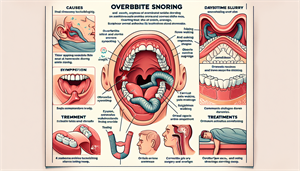
Understanding Overbite Snoring
Struggling with an overbite and nightly snoring? Understanding the connection between overbite snoring and disrupted sleep is critical. This concise guide addresses your main concerns directly: Can an overbite cause snoring, and what can you do about it? Discover key signs, health implications, and the best ways to treat overbite snoring, paving the way to restful nights ahead.
Key Takeaways
-
Severe overbites can lead to breathing issues and obstruct the airway, potentially causing snoring and obstructive sleep apnea, which can be alleviated through proper orthodontic treatment.
-
Orthodontic treatments, including braces, Invisalign, jaw surgery, and mandibular advancement devices, cater to varying severities of overbites and can significantly improve sleep quality by reducing snoring.
-
Untreated overbites can cause various health issues such as tooth and jaw damage, gum disease, and exacerbated snoring; thus early orthodontic intervention and lifestyle modifications are essential for managing symptoms and preventing complications.
Exploring the Connection: Overbite and Snoring
Severe overbites can lead to chronic breathing issues, suggesting a possible correlation with snoring. When you have an overbite, your teeth overlap in a way that your top teeth significantly cover your bottom teeth. This condition, also referred to as buck teeth, may cause your airway to become blocked, leading to loud snoring and disrupted sleep. Additionally, snoring might be a sign of a more serious health condition like sleep apnea. This sleep disorder can obstruct the intake of necessary oxygen, thus hindering the attainment of deep sleep. Proper treatment of overbite can help eliminate snoring altogether, allowing you to sleep peacefully. Fortunately, orthodontic care can efficiently treat dental overbites, offering solutions to reduce snoring and improve sleep quality.
The Anatomy of Snoring: How Overbites Play a Role
Comprehending how an overbite contributes to snoring requires initial understanding of the anatomy of snoring and the various kinds of overbite. Snoring is a prevalent occurrence that arises from obstructions within the throat, impeding the free flow of air and resulting in vibrations that produce the characteristic snorting sound. Teeth grinding can also contribute to snoring. Within this framework, we will examine two forms of overbite - dental and skeletal, and their role in snoring.
Identifying Overbite-Related Snoring
To assess the presence of an overbite, one can utilize a mirror to smile and show the upper teeth while gently biting down. If only 50% or less of the lower teeth are visible, it may indicate the presence of an overbite. However, it is advisable to seek confirmation from an orthodontist as they can provide a detailed evaluation of your bite and suggest appropriate orthodontic treatment. Professional dental examination plays a crucial role in the identification of overbite-related snoring.
Dentists are able to detect signs of obstructive sleep apnea, evaluate the alignment of the teeth, and screen for related comorbid conditions and risk factors, such as jaw pain. Primary diagnostic tests used to identify snoring related to overbite include flexible nasopharyngoscopy and the decision rule. These tests can also help identify deep bite issues.
When Overbite Meets Obstructive Sleep Apnea
Individuals with overbites, including buck teeth, are more susceptible to developing obstructive sleep apnea as a result of the snoring and breathing difficulties associated with overbites during sleep. An overbite can potentially contribute to obstructive sleep apnea by causing snoring and impacting the alignment of the jaw and the width of the airway, which can increase the risk of developing sleep apnea, especially when the upper jaw protrudes significantly.


